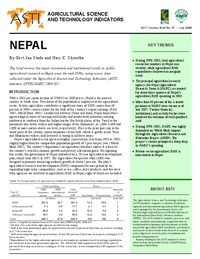Authors:
Stads, Gert-Jan; Shrestha, Hari K.
Year:
2006
Publisher
International Food Policy Research Institute (IFPRI); and Nepal Agricultural Research Council (NARC)
Back to:
Overall, agricultural researcher numbers in Nepal increased during 1996–2003, while the country’s agricultural R&D expenditures followed a more irregular trend. Nepal’s principal agricultural R&D agency, NARC, was highly dependent on the World Bank-financed project AREP, which ran from 1998 until 2002. The closure of this project led to a sharp fall in the council’s and the country’s agricultural R&D spending, prompting the Nepalese government to increase its funding to NARC. A distinctive feature of agricultural R&D in Nepal, compared with many other countries in the region, is the significant role of the nonprofit sector in agricultural research, which is funded entirely by foreign donors.
The agricultural sector has been identified by the Nepalese government as the primary engine for economic development. To this end, the government launched APP in 1995, a plan to accelerate annual agricultural production growth to about 5 percent during 1995–2015. Nevertheless, the country’s average agricultural production growth was only 3 percent per year during 1995–2003, identical to the growth rate a decade prior to the launch of APP (World Bank 2005). NARC anticipated increased funding from the government at the onset of APP, but, in reality, NARC’s share of the national budget has steadily fallen in recent years.
In addition to these financial challenges, certain institutional and security factors continue to hinder NARC in attracting and retaining qualified research staff. As of December 2005, just 56 percent of the council’s available scientist positions were actually filled, mainly due to the fact that many scientists regard NGOs as much more attractive employers in terms of salaries. Most of NARC’s scientists are based in or near Kathmandu, limiting the ability to respond appropriately to the needs of farmers in the country’s more remote areas.

